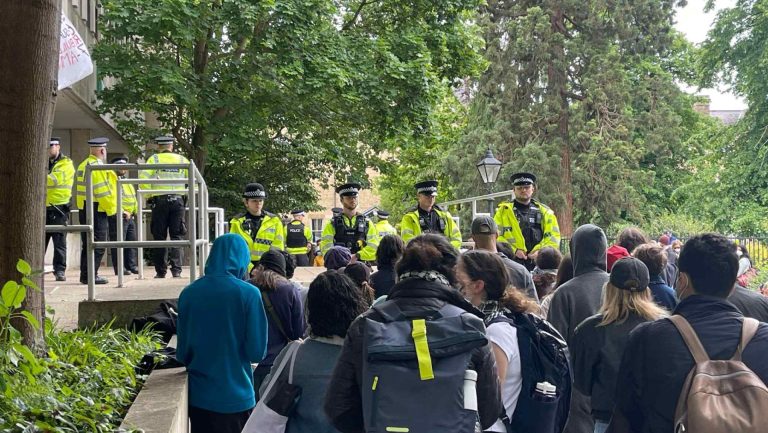“What is the point of a university like Oxford if we don’t have the boldness, integrity, and confidence to think differently, to think deeply, to speak truth to power?” asked Oxford’s Vice-Chancellor, Irene Tracey, in an address at her Admission Ceremony in January, 2023.
Throughout its long history, Oxford has been an important stage for student activists for a variety of causes, ranging from climate change prevention to protesting increases in rent. Universities have long served as a beacon for political and social discourse, facilitating the open debate of topics which matter to its students. But recent crackdowns on student-led protests around the world have led to universities being accused of failing to support this.
As increasing restrictions, including the Public Order Act 2023, reshape the national landscape, tensions between Oxford students and the University administration over recent demonstrations raise urgent questions – does this signal a new chapter in the institution’s approach to activism?
Cherwell has gathered testimony from Oxford students involved in activism over the past year, many of whom have been met with varying degrees of disciplinary action. Due to the ongoing nature of some University investigations, students’ identities have been kept anonymous. Through their accounts, Cherwell aims to investigate how the culture of student protest in Oxford is evolving.
University policy on demonstrations and protests
University guidance on the right to protest states: “‘The University supports the right to lawful protest, but actions which disrupt aspects of staff or student life for fellow members of the University, in breach of our codes of conduct, are not acceptable.”
The right of students to express opinions “without institutional censorship and without placing themselves in jeopardy of losing their jobs or privileges” is protected under the University’s Code of Practice on Freedom of Speech, if they are granted permission from the Proctors’ Office before demonstrating. The Code of Practice also states that protests will be prohibited if they pose a risk to public safety or give rise to an environment of discrimination.
The University proposed changes to Statute XI, a statute concerning University disciplinary measures, in the Trinity 2024 Week Eight newsletter. The proposed amendments were set for a Congregation Vote on June 11th, 2024. However, some amendments were criticised for being vaguely worded, such as the proposal that staff should have the power to ban students for up to three weeks who could be “likely” to “cause damage to property” or “significantly damage the University’s reputation among reasonable people”.
The proposed amendments to Statute XI also included modifications to punishments for sexual misconduct and harassment; an email from the University to department heads and heads of colleges stated that a “vote against the proposed statute is a vote against the introduction of the sexual misconduct reforms”.
One student who spoke to Cherwell accused the University of using the modified penalties for sexual harassment to enable the blanket approval of more severe punishments for all disciplinary offences, criticising the combination of what they referred to as “draconian changes to the behavioural policy with the very legitimate sexual harrassment policy”.
After intense backlash from students and faculty, the amendments were withdrawn, and the Congregation vote was cancelled.
A University spokesperson told Cherwell: “Proposed changes to Statute XI—now under further consultation—were designed to strengthen the University’s ability to address serious misconduct, particularly in cases of sexual harassment and violence. These proposals were not intended to restrict lawful protest, which remains protected under University policy and UK law.”
A recently published UN report, which Cherwell has been told was written after interviews held between Oxford student protestors and the UN Special Rapporteur, has strongly condemned the growing use of disciplinary action against student activism, warning of “a deeply disturbing situation” and a worsening “atmosphere of hostility and mistrust between the students and the administration” in academic institutions worldwide.
A University spokesperson told Cherwell in response: “We are aware of references to a recent report by the UN Special Rapporteur on student protest. While the report addresses global trends and includes examples from the UK, it does not name Oxford or make any specific findings about the University.
“The University of Oxford is committed to freedom of speech, the right to lawful protest, and the safety and wellbeing of our community. These values are fundamental to academic life and are supported by the University’s Code of Practice on Freedom of Speech and Guidance on Protests and Demonstrations.
“We do not discipline students for their legally held views or causes. However, when protest actions involve serious disruption, forced entry, harassment, or safety risks, we respond in accordance with University policies. Our approach is guided by fairness and a responsibility to maintain a respectful, safe, and inclusive environment for all students, staff, and visitors.”
Disciplinary action and its impact on student protestors
Just over a year ago on 23rd May 2024, 17 members of OA4P operated a sit-in at the University’s administration offices in Wellington Square in an attempt to push for negotiations with the University. In response, the University called the Thames Valley Police (TVP) to arrest those inside and break up the students protesting outside the building.
A student who was present at the incident told Cherwell: “the amount of people that were injured… was kind of astonishing. People were being dragged and pushed around for no reason, there was simply no reason to use that amount of force, and it was with the University’s permission that that happened”.
One student told Cherwell that the University’s response to the Wellington Square incident “backfired for the University… a lot of Oxford students who saw the videos of the police acting the way they did started supporting the encampment, to be honest, (…) they felt like the University’s mistreatment of the students specifically was appalling.”
The University claimed in the University newsletter following the students’ arrest, that the students involved engaged in “violent action that included forcibly overpowering the receptionist”. OA4P previously told The Oxford Student: “there is CCTV footage which disproves the false allegation that acts of violence took place.” In response to a Freedom of Information request for CCTV footage of the reception area, the University told The Oxford Student that it was not able to provide the information requested.
TVP initially arrested one of the 17 students for assault, but later decided not to bring charges. The University then launched a Proctors’ investigation into the incident, and members of OA4P told Cherwell that a verdict is yet to be provided on the disciplinary actions to be taken against the students. Over a year after the incident, the Proctors’ investigation remains open.
One student who is currently under Proctors’ investigation following the Wellington Square incident told Cherwell that they feel as though the inconclusive nature of the disciplinary process is “being done intentionally to silence us… I am intentionally being kept on counter hooks [sic] so that I don’t do anything else.” They added that they are constantly “looking over [their] shoulder” as a result of fearing further disciplinary measures from the University.
A different student told Cherwell that they had experienced distress and anxiety as a result of the ongoing investigation: “Continuing to have this weight hanging over me without a sort of acknowledgement of how it could affect my studies, my life, my health… is not proper conduct from them”.
A University spokesperson told Cherwell: “We aim to ensure that disciplinary processes are consistently fair, clear, and proportionate. These processes are confidential and conducted independently of University leadership.”
A recent investigation by Liberty Investigates and Sky News revealed through Freedom of Information requests that the University received intelligence reports on protest activity from the private firm Horus Security Consultancy Ltd, a company which has previously been criticised for being used as surveillance to investigate student activists at Sheffield University.
One student told Cherwell they felt that “the surveillance was designed to induce some kind of paranoia”. They added: “Whatever mental health impacts it has, which I can first-hand tell you are quite serious, do not even come up in theoretical conversations [with the University].”
In response to these claims, a University spokesperson told Cherwell: “Allegations of surveillance are also inaccurate. External security consultants are used solely to carry out safety risk assessments for public events and known protests—not to monitor individuals or political activity.”
Looking to the future of student activism
On 16th May 2025, Oxford Against Genocide (OAG), which decribes itself as “a new collective in Oxford who are dedicated to Palestinian liberation”, set up an encampment outside Magdalen College.
Magdalen wrote a letter to the protesters on the same day asking them to leave, and threatened court action, so the encampment was moved to the Angel and Greyhound Meadow. However, a representative told Cherwell that pressure from University security forced the encampment to disband the following weekend.
One student involved in OAG described encampments as a “disruptive but not destructive” form of protest, and “a normal course of action for student protest in this country”.
The student compared the recent disbanding of OAG’s encampment with their involvement in the OA4P encampments last Trinity: “Last year, the University tried to kind of wait it out… This time round the response has been a lot more harsh. Their tolerance for hearing protest… has decreased.”
Following the recent dismantling of OAG’s encampment, tensions between protestors and University administration raise questions about what the future of Oxford’s student activism will look like.
Several students who spoke to Cherwell reported feeling that the disciplinary action taken by the University resulted in fear surrounding the potential consequences of participating in future demonstrations. One student stated: “They’re very interested in creating an atmosphere in which protest is very uncomfortable and impractical”.
Another student cited the Vice Chancellor’s speech about “speaking truth to power” to argue that the University pays “lip service towards the idea of student democracy and student action… When you actually do it, you’re faced with this massive bureaucratic wall.”
A University spokesperson told Cherwell: “In both the 2023 and 2024 National Student Surveys (NSS), Oxford students reported among the highest levels of freedom of expression in the country—with 90.8% and 89.9% respectively responding positively to how free they felt to express their ideas, opinions, and beliefs. In 2024, 1,749 Oxford students responded to this question, offering a strong and representative picture of student experience.
“As a global institution, Oxford thrives on challenge and critical thought. We are proud to remain a space where robust debate and diverse voices are not only protected but valued.
Student demonstrations over the past year signal that the landscape of Oxford’s student activism is constantly evolving, raising questions about the boundaries of protest, the roles of universities in fostering independent thought, and the extent to which institutions are willing to support, or suppress, student voices. If there is belief that tangible change can be achieved through activism as it has done before, students in Oxford and beyond will continue to speak out about the causes which matter to them, influence progress, and challenge those in power for decades to come.
Disclaimer: Asma Issa, one of the writers, was a member of OA4P









